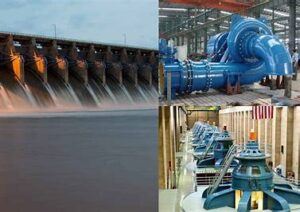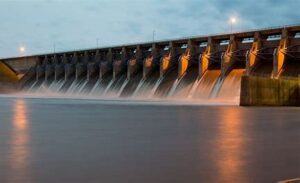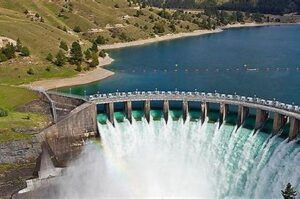I turn on my faucet and watch water cascade into the sink. It’s a daily ritual many consider mundane, but hidden within this stream is a power that has been fueling civilizations for centuries: hydropower. Hydropower, or water power, is the energy generated from the movement of water, usually through turbines that convert it into electricity. It’s a form of renewable energy that draws its strength from the natural water cycle, making it a critical component in the shift towards sustainable power.
The science behind water power is based on two primary forms of energy: kinetic, the energy of motion, and potential, the stored energy. Water at a great height has potential energy, and as it moves downwards, this energy transforms into kinetic, driving turbines to produce electricity. This transformation has historically powered everything from ancient water wheels to modern hydroelectric dams.
Reflecting on the past, it’s evident that hydropower has always played an instrumental role in human development. The Greeks used water wheels to grind wheat into flour, and the Industrial Revolution saw a surge in hydropower usage to mechanize various processes. Now, this legacy lives on in electricity generation. An array of high-tech solutions ranging from vast dam structures to sophisticated turbines now capitalize on the power of flowing water.
Grasping the contributions of hydropower requires a look at current technologies in the field. Hydroelectric dams, for instance, leverage the height of stored water to generate power, while run-of-the-river systems make the most of the continuous flow of rivers. There’s also growing attention on small-scale, low-impact solutions suitable for smaller water systems, ensuring that hydropower remains adaptive to diverse environments.
Harnessing Hydropower: From Rivers to Electricity
I’m here to walk you through the fascinating process of transforming the natural flow of water into a powerhouse of electricity. Now, imagine a river coursing through the landscape. Its relentless energy and the sheer force of moving water aren’t just scenic spectacles; they are potential sources of immense power.
By introducing you to the inner workings of hydropower plants, I aim to demystify how these marvels of engineering capture that kinetic energy. Picture gigantic turbines spinning as water rushes through them, a straightforward, yet ingenious, method for generating electricity. The method? Water’s movement turns the blades, which spins a generator, and voila, you have electricity.
I can share stories of existing hydroelectric plants—from the towering Hoover Dam in the United States to the expansive Three Gorges Dam in China. These facilities stand as testaments to the capabilities of hydropower, serving millions with clean energy.
Yet, while the benefits are vast, I must underscore the need for environmental mindfulness. I’ll navigate you through the delicate balance required to exploit hydropower without harming our precious ecosystems. This involves careful planning and technology designed not to disrupt aquatic wildlife or the river’s natural flow.
The economic and social upsides are also compelling. Communities around the world find that once the infrastructure is in place, the ongoing costs of electricity generation can decrease significantly. Moreover, hydropower creates jobs, stimulates economic growth, and, in some cases, provides a reliable source of clean water.
But how does this all tie back to you and your community? Can you harness this form of energy where you live? Let’s explore what it might mean to tap into hydropower on a local scale and how doing so could ignite a sustainable, energy-rich future for your neighborhood.
Empowering Our Community with Hydropower
Our community has the potential to harness the power of hydropower, a step that could revolutionize the way we think about and use energy. To explore this possibility, we first need to examine the capacity of our waterways. Do they have the right flow and drop to generate electricity? Environmental assessments and feasibility studies can answer these questions, guiding us on whether a hydropower project is a practical option for our area.
When I consider the steps we must take to make hydropower a reality here, I’m reminded of successful initiatives in other communities. These projects often start small, with local leadership and citizen involvement, integrating sustainability and education. Through community meetings and partnerships with experts, we can lay the groundwork for our own project and learn from others who’ve already navigated this path.
If moving forward is the consensus, the first action item is to lay out a clear plan. This involves setting up transparent goals, ensuring regulatory compliance and securing funding, whether through grants, private investments, or public partnerships.
Looking ahead, the future of hydropower in our community could be bright. We’re not just talking about traditional uses like electricity generation; we could explore innovative applications such as water management, irrigation, and even recreational opportunities that could boost local tourism. Ultimately, a successful hydropower project here could mean a cleaner, more sustainable, and self-sufficient future.


